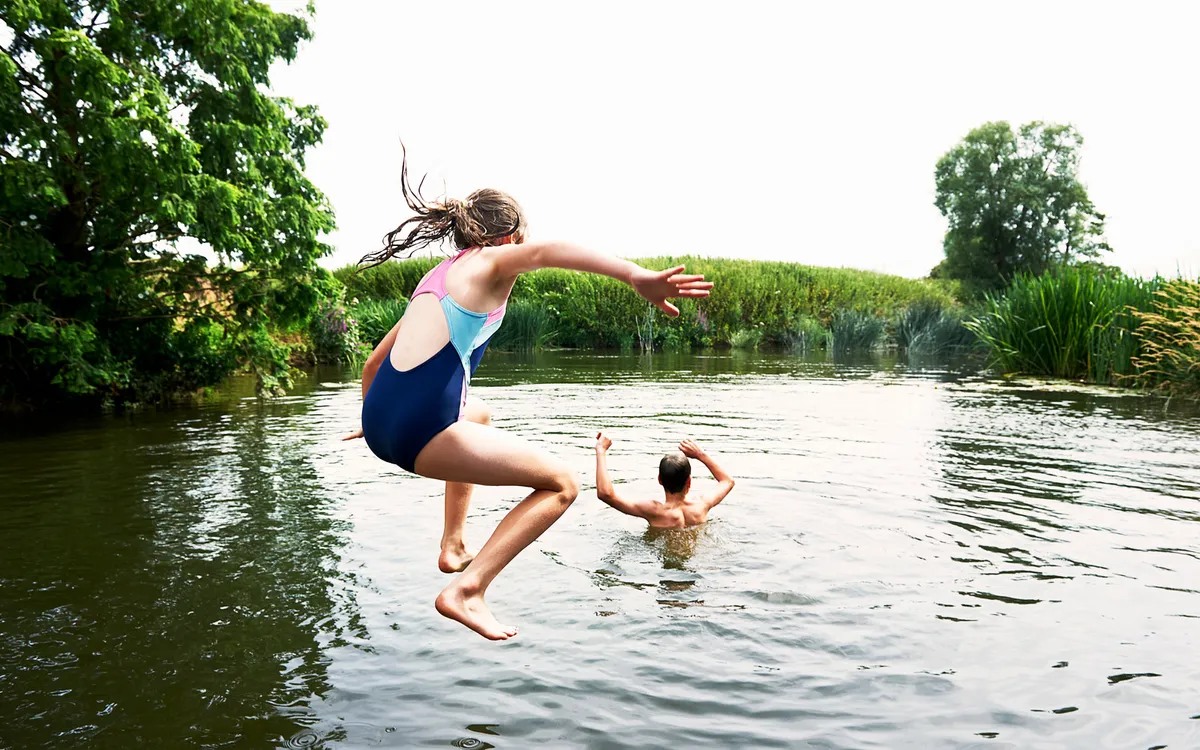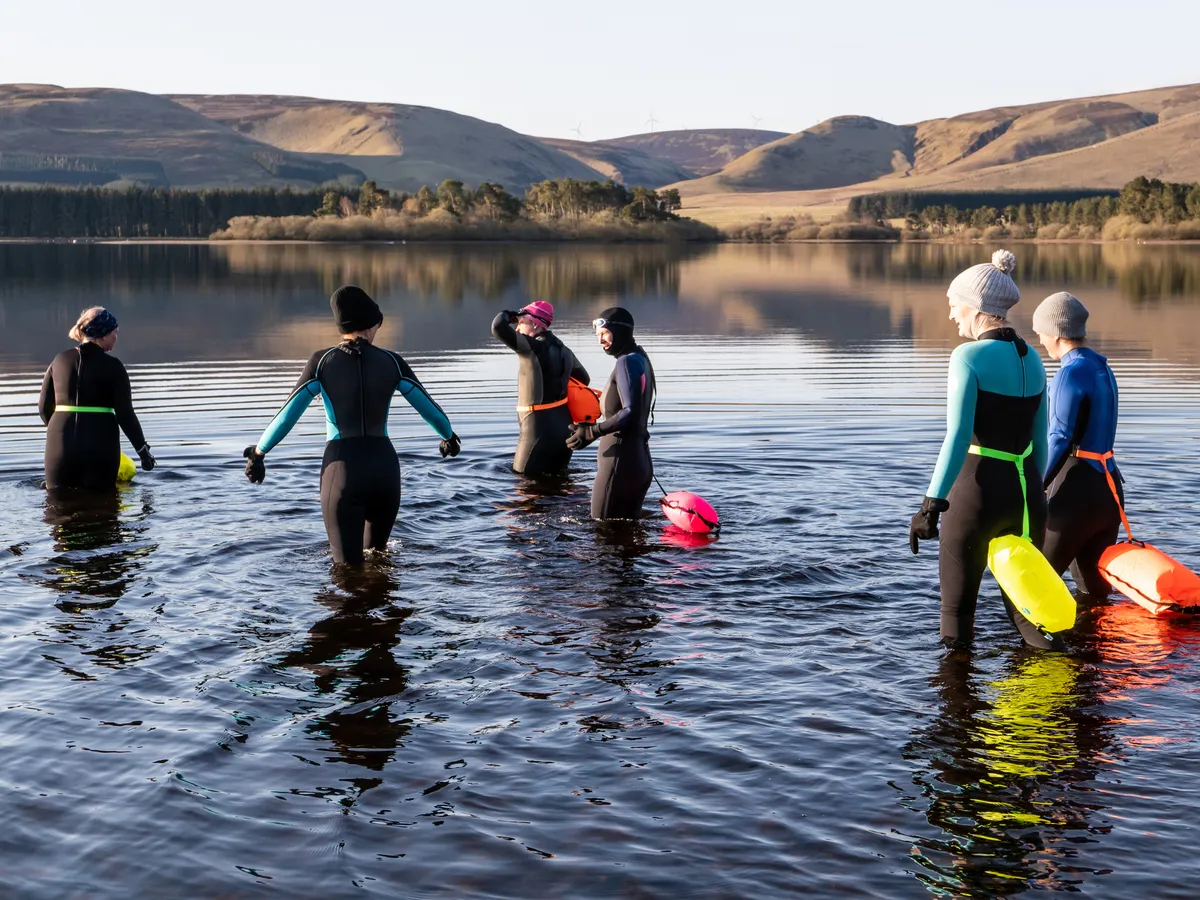Reservoirs may look inviting, but factors such as extreme cold, underwater currents and steep banks are just some of the reasons given by water companies for banning public swimming in them. However, there is a growing movement calling for open access rights.
It began in 1932, when the Kinder Mass Trespass saw 400 ramblers climbing Kinder Scout, an event that went down in history as having helped establish the principle of open access land and lay the foundations for the introduction of the UK’s National Parks. This year, on 26 April – the 90th anniversary of this event – the Outdoor Swimming Society organised a ‘swim trespass’ of Kinder Reservoir in an attempt to call for greater access rights to reservoirs and bodies of water around the UK.
But even if we could legally swim in reservoirs, is it actually safe to do so?

Kinder Reservoir is owned by United Utilities, a company that operates a blanket no-swimming ban in its waters. It was among the most vocal critics of swimming in reservoirs last summer, after 31 people drowned during England’s heatwave.
“They turn up in wetsuits,” said Mark Seymour, UU’s catchment manager for Manchester, last year. “They’re usually adults, and are setting a dangerous example because other younger people might see them swimming and get the wrong impression that it’s OK to swim too. These open-water swimmers could indirectly be the cause of another drowning tragedy.”
Where else can I swim outdoors?

Why are you not allowed to swim in Kinder Reservoir?
“Kinder Reservoir is an operational site with deep, cold water and hidden hazards,” says a spokesperson from United Utilities, the company that owns the reservoir. “The reservoir is constantly supplying water for the Stockport area so there are also strong currents below the surface.”

Is it illegal to swim in reservoirs in the UK?
In Scotland, swimmers enjoy the right to swim freely in almost all Scottish reservoirs, thanks to the 2003 Land Reform Act and ‘right to roam’.
In the rest of the UK, issues arise in the fact that reservoirs are usually owned by water companies. The Water Industry Act 1991 states that water companies must ‘ensure that the water or land is made available for recreational purposes and is so made available in the best manner.’
In accordance with their legal duty to provide public access for recreation to the land and water, many allow fishing and boating but not wild swimming. Essentially, it is down to the discretion of the water company or landowner.
Since the increase of interest and engagement in wild spaces since the Covid-19 lockdowns of 2020 and 2021, landowners and water supply companies are worried about the impact the increased footfall may have on their reservoirs.
Is swimming in reservoirs dangerous?
Because of the man-made nature of reservoirs, they do carry additional risks to other bodies of water. However, the Outdoor Swimming Society have argued that they are also free of risks such as flow, currents and tides – all hazards you can expect in rivers and the sea.
What are the pros?
Reservoirs generally have high water quality, because they are carefully managed and are built upstream from significant areas of pollution. Unlike many other rivers and lakes, reservoirs are fairly clean.

There are around 2000 reservoirs in England and Wales, which, if they were to be opened up, would create a huge quantity of new swimming spots around the UK, thus reducing overcrowding and overuse of other spaces.
According to the 2021 National Water Safety Forum annual report, 81 accidental deaths were recorded by the coast last year, 37 in lakes, 76 in rivers and 14 at sea. Comparatively, there were 8 fatalities in reservoirs: just two more than the six deaths recorded in baths, jacuzzis and hot tubs. But that's not to say that reservoirs are safe to swim in.
What are the risks?
There are many risks to swimming in reservoirs.
- Reservoirs have steep banks, so getting in and out of the water can be challenging.
- Reservoirs are always very deep – but there may also be changes of depth.
- There may be blue green algae in the water or built up along the water’s edge. This is a type of bacteria called cyanobacteria that is poisonous to animals and humans.
- The temperatures of reservoirs are often cold, so if you’re not acclimatised your body might experience cold water shock.
- Dams and towers pose real risks, so give both a very wide berth. Dams have spillways where water can be released when the dam is overflowing. Towers are usually placed close to the dam and contain pipes that take the water off for drinking or hydroelectric power, depending on what the reservoir is being used for. This can pull swimmers under.
- Aerators are often kept in reservoirs to keep the water ecologically balanced. They inject air bubbles into the water from the bottom of the reservoir to introduce oxygen. This can lead to negative buoyancy, meaning that swimmers will struggle to stay afloat. Aerators are often marked with buoys, so keep an eye out for those.
- Reservoirs are often located in isolated areas, a long way from emergency services.
- Pumps can be operating below the surface to move the water around.
Which reservoirs can I swim in?
There are a number of reservoirs in the UK where swimming is allowed.
Sparth Reservoir, West Yorkshire
In 2011, ‘No Swimming’ signs were introduced on the banks of Sparth Reservoir, despite people having swum there for decades. A group of swimmers spent years doggedly trying to revoke this rule, with ‘splash mobs’, petitions and negotiations with the Canal and River Trust. In 2017, the signs were finally replaced, and now Sparth Reservoir has free open swimming access.
Rutland Water

Rutland’s reservoir is not only used for water storage, but is also a popular sports centre, with facilities for fishing, walking, cycling and a cafe. On its north shore lies 140m of sandy shoreline, managed by lifeguards and free to use in the summer months.
Carding Mill Valley Reservoir, Shropshire
The New Pool Hollow walk is managed by the National Trust, and takes you from Carding Mill Valley up to the reservoir bank. Although the National Trust initially put up signs prohibiting swimming in this disused reservoir, a site risk assessment was carried out in 2010 which deemed it safe to use. Wild swimming safety signs were installed, along with throw lines and buoys showing swimmers where the depth exceeds 1.4m. It’s now a popular swimming spot.
Harthill Reservoir, Rotherham
Harthill is a functioning reservoir and is the main supply and water reserve for the Chesterfield Canal – but it’s also home to the Rotherham Sailing Club and Yorkshire Outdoor Swimmers. The open-water swimming club meets every Saturday all year round.
How to swim safely in reservoirs
The general rules for swimming safely in reservoirs are the same as for any other body of water.
- Make sure that swimming is permitted in the reservoir you want to enter.
- Make sure you have an easy entry and exit point for your swim, avoiding steep banks. Remember that if you’re cold on exit, you might lose muscle strength, and your motor skills can seize up.
- Always check for obstructions, particularly any infrastructure or man-made structures.
- Don’t swim outside of your capabilities, whether that’s your swimming skills or your acclimatisation to cold water.
- Avoid buoys, because they may signal the presence of an aerator.
- Don’t drink alcohol or take drugs before entering the water – for obvious reasons.
